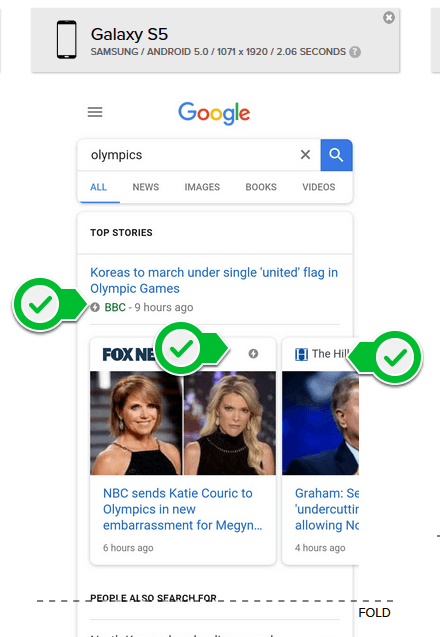Every ecommerce manager knows that Google rankings are central to success. The algorithms of the Internet giant determine whether your organization prospers or perishes. In this article, I discuss how Google’s Accelerated Mobile Pages can give you a leg up, enabling your mobile pages to leapfrog to the very top of the search engine results page (SERP) for your favorite keywords.
Rankings’ Royal Road to Success
Yes, SERPs are decisive for your digital marketing strategy. The competition for that most precious piece of real estate is fierce and for good reason — if you don’t appear in page one search results, you’ve lost 90% of users. That’s right, under 10% of users click to see the second page and only about 1% engage with page 3 results. If they don’t see your website, they can’t engage or convert.
Further, the top 3 results capture over 60% of clicks, and the top 5 combine for 75% of clicks. So, not only do you need to be on page one, you need to be above the fold.
SEO – All the More Crucial on Mobile
Mobile users are typically driven by the need for search results that are usable in-the-moment. Window shopping, relaxed browsing and extended scrolling are reserved for downtime on the couch with tablet in hand. While driving, speeding to an appointment or scrambling before a meeting, mobile users want actionable info in an instant. Given users’ immediate need, appearing above the fold on page one is exponentially more important for mobile.
Google’s Accelerated Mobile Pages Conquers the World (Wide Web)
That need for speed for fast results now if not 10 minutes ago helps explain Google’s ambitious AMP strategy. Google’s Accelerated Mobile Pages are an open-source coding project designed to remedy one critical flaw in mobile delivery – slow page load times that challenge the limited patience and attention span of today’s consumers. With AMP, you get a drastically slimmed-down and speedier version of articles, often delivered from Google servers strategically located around the globe. When a landing page is an enhanced AMP version, Google highlights it with a small lightning bolt in the search results, and then it loads fast, yes, way faster than it takes to discover what famous artistic masterpiece you most resemble.

Google’s AMP Project was provoked in part by Facebook’s “Instant Articles,” an almost instantaneous loading of news reports to the impatient youngsters of Gen Y. And the Accelerated Mobile Pages project has responded in spades, knocking its own load times down below the one-second mark. That’s four times faster than the average non-AMP page — sufficient to satisfy even the most time-stressed millennial.
Now Google is pushing the application of AMP beyond news and content publishers to all mobile search results. One of Google’s first partners was eBay, extending Accelerated Mobile Pages coding and speed to the mobile pages of its mega-marketplace. Since then, major firms thoroughly dependent on ecommerce like TripAdvisor, Disney, Food Network, Drugs.com, and even the NFL have converted many of their pages to AMP, reports TechCrunch.
The AMP SEO Strategy
Google has always proclaimed that satisfying users is its number-one goal, through delivering relevant, useful search results. And as Google recognizes, the vast majority of searches today (57% by some estimates) are conducted on mobile.  So, it’s no surprise that Google has increasingly taken mobile friendliness as a relevant criteria in determining rankings. At Mobile1st, we tell our clients a mobile-friendly website is a business necessity.
So, it’s no surprise that Google has increasingly taken mobile friendliness as a relevant criteria in determining rankings. At Mobile1st, we tell our clients a mobile-friendly website is a business necessity.
But now Google has announced that speed, in particular mobile speed, will be a major factor in your SEO ranking. In its “Speed Update,” which will go live this summer 2018, Google will assess the load times of your mobile pages before delivering its search results.
Certainly there are significant steps you can take to reduce your mobile load times. But AMP is clearly another powerful strategy to ensure you are performing your best for Google’s updated algorithm by delivering mobile friendly pages so fast they can satisfy even the most jaded consumer.
So now Google evaluates your site’s speed and mobile friendliness, and they spotlight your AMPed-up pages. Google typically features Accelerated Mobile Pages content at the top of page one, often in a carousel of relevant results.
AMP’s Critical Role
Yes, it’s clear that Accelerated Mobile Pages should play a critical role in your mobile SEO strategy. With AMP, you can:
- Ensure mobile friendliness, satisfying a major Google ranking criteria
- Deliver stunningly fast load times, again meeting Google’s new Speed Update standard
- Grab top spots in Google’s featured top-of-page-one carousels
And last but not least, the AMP lightning bolt attracts readers who know that it signifies immediate gratification. You can learn more about implementing AMP to your mobile pages, read here, or consult the Mobile1st mobile optimization team today.
- How to Supercharge Mobile CRO with Conversational Commerce - May 8, 2018
- Mobile Conversion Rate Optimization and the iPhone X - April 10, 2018
- Conversion Rate Optimization: How to Use SEO to Improve Your CRO - February 25, 2018
